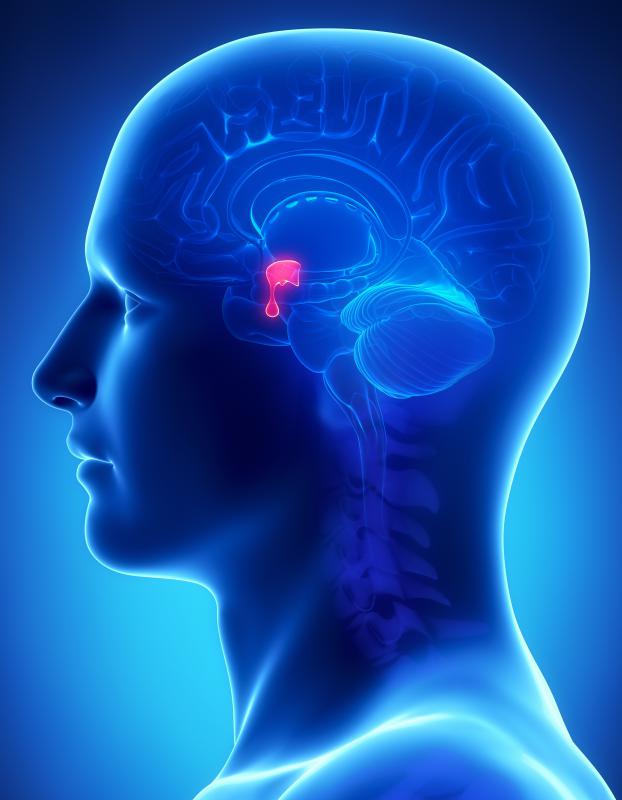At TheHealthBoard, we're committed to delivering accurate, trustworthy information. Our expert-authored content is rigorously fact-checked and sourced from credible authorities. Discover how we uphold the highest standards in providing you with reliable knowledge.
What is a Brain Neoplasm?
A brain neoplasm, commonly known as a brain tumor, is a collection of abnormal cells originating within the brain tissue. Depending on its type, a brain tumor may be benign or malignant in its composition. Treatment for this potentially serious condition is dependent on several factors, including the location of the tumor, and frequently involves the surgical excision of the growth, as well as the application of chemo and radiation therapies. Complications associated with this condition are dependent on the location of the tumor and may include seizures, chronic headaches, and impaired vision.
Despite the various manifestations associated with a brain neoplasm, the origins of its presentation generally fall under one of two categories. Those that originate within the brain tissue are referred to as primary tumors and may be benign (non-cancerous) or malignant (cancerous) in composition. When a tumor forms within the brain in the presence of an existing cancer in another part of the body, it is considered to have metastasized from the original cancer to become a secondary brain neoplasm and is malignant.

There is no known cause for the abnormal cell development associated with the formation of a primary brain neoplasm. Generally, a primary neoplasm may form within the actual brain tissue or its supportive tissues, such as the meninges. Organs in the immediate area, including the pineal and pituitary glands, may also host the initial development of a primary brain neoplasm. Considered a rare condition, a primary brain tumor is generally named for its cell composition, such as Meningioma or Pineoblastoma.

Though most secondary neoplasms are known to be metastatic in nature, some may form in the presence of an undiagnosed cancer. In most individuals, neoplastic formation occurs due to an aggressive, existing malignancy, such as colon, breast, or lung cancer. There are some instances where the presence of a brain tumor may serve to indicate the existence of a cancer which, until that point, had remained undiagnosed.

Generally, individuals with a brain neoplasm will develop sensory dysfunction. Impaired vision, hearing, and speech are common signs of the presence of a brain tumor. Some people may experience psychological issues that present as erratic moods or personality changes. A gradual onset of paralytic sensations in the limbs or seizures may also develop as the tumor matures. Additional signs of a brain neoplasm may include impaired cognition, chronic nausea and vomiting, and persistent headache.

Following an initial consultation and physical examination, an individual is usually referred for further diagnostic testing. Individuals may undergo a battery of imaging tests that often include magnetic resonance imaging (MRI) and positron emission tomography (PET) and computerized tomography (CT) scans. Though much of the imaging testing is focused on the head and neck area, an evaluation of the rest of the body may be performed to check for abnormalities indicative of malignancy. A neurological examination assessing the presentation of the individual’s sensory and motor capabilities is generally standard procedure. Additionally, a biopsy by stereotactic needle may be taken to obtain a sample of the neoplasm and surrounding tissue for further analysis.

Treatment for a brain tumor is dependent on multiple factors, including the location and size of the tumor. The first step of any treatment approach is frequently the surgical excision of the abnormal growth. When the tumor is operable, meaning it is located in an area of the brain that is conducive to excision, it is removed along with some of the surrounding tissue that may be sent for further laboratory analysis. If the tumor is inoperable, meaning its excision would be too risky, other treatment options may be pursued.

Chemo and radiation therapies are generally administered to target and eliminate any residual malignancy, such as a remaining portion of the tumor. The administration of chemotherapy may occur either orally or intravenously and involves the use of drugs to eliminate any existing cancerous cells. Individuals who undergo chemotherapy generally experience side effects that can include nausea, vomiting, and fatigue. Radiation therapy involves the use of highly concentrated energy waves to destroy cancerous cells. When used to treat a brain neoplasm, side effects associated with radiation therapy are dependent on the application method and may include fatigue and inflammation at the administration site.

Additional treatment options can include the use of radiosurgery and cancer-specific drug therapy. Despite its moniker, radiosurgery is not an operation, but a single-application, medicinal therapy. Unlike traditional radiation therapy, radiosurgery involves a more concentrated dose of radiation that can cause pronounced fatigue and nausea. Drug therapy involves the administration of additional medications, similar to those utilized during chemotherapy, that are designed to target and eliminate residual cancerous cells.
AS FEATURED ON:
AS FEATURED ON:


















Discuss this Article
Post your comments